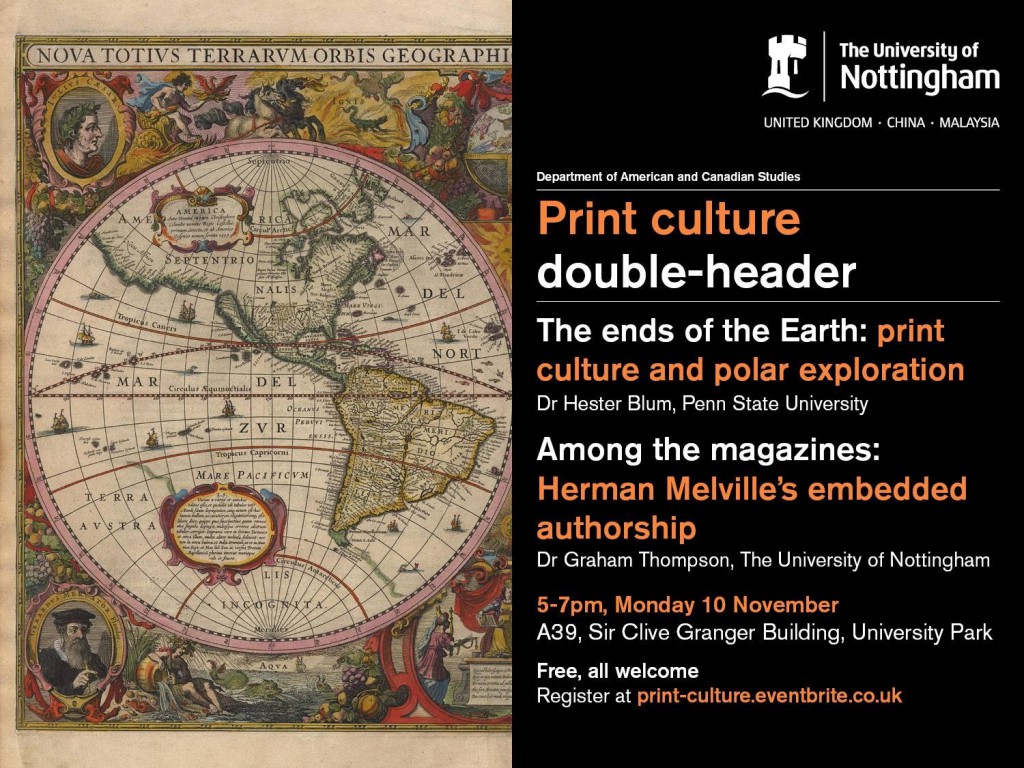
06/11/2014, by CLAS
An Evening of Print Culture
Hannah Murray is a PhD student in American & Canadian Studies, where she is writing a thesis on liminal whiteness in nineteenth-century American literature. In this post, she looks forward to welcoming Dr. Hester Blum, a leading scholar in nineteenth-century print culture studies.
When we read a novel or short story we may not think about how the book or magazine arrived in front of us. But who ordered the paper it’s printed on? Where was the text assembled? How did it get to the bookstore? Today, with the dominance of giant publishing houses and chain bookshops we may take this for granted, but what would have happened 150 or 200 years ago?
Print culture studies unite the history of the book, authorship studies and literary criticism to uncover how texts were produced and examine the effect physical form has on content. The field also explores what we may call ‘extreme printing’: where networks of writers, printers and readers existed in the most unusual or unexpected conditions. The Department of American & Canadian Studies is home to a growing academic hub in this area, with researchers tracing the ‘vertical networks’ of nineteenth-century American magazines, from paper manufacture to sales and transatlantic readerships.
On November 10th Dr. Hester Blum, Associate Professor of English at Pennsylvania State University, will join us in an evening of print culture discussion. Dr. Blum is a leading scholar in nineteenth-century American literature and her work examines print cultures in oceanic and polar settings. Her first book The View from the Mast-Head: Maritime Imagination and Antebellum American Sea Narratives (2008) examines first-person narratives of working sailors in autobiography and fiction to argue that antebellum sailors were a ‘remarkable population’ of readers and writers, whose work was intertwined with their literary imaginations. This work received the John Gardner Maritime Research Award for its significant contribution to understandings of nineteenth-century maritime culture.
Dr. Blum is currently at work on a new book about the print culture of polar exploration The Ends of the Earth: Oceanic Studies and the Print Culture of Polar Exploration, which will be the subject of her talk. The Arctic and Antarctic acted as truly global frontiers in the Nineteenth Century and early Twentieth Century, with journeys undertaken by American, Canadian, British, Russian and Norwegian explorers and traders. Workers on board these vessels, away from home for long periods of time, produced their own newspapers as a form of entertainment and internal communication. These fascinating archival sources provide readers with unique perspectives of life on board ship and of the strange polar worlds these men entered.
Accompanying Hester Blum will be Dr. Graham Thompson, Associate Professor in the Department of American & Canadian Studies. Dr. Thompson is a leading expert on Herman Melville and is currently researching Melville’s magazine work. Although best known today for Moby Dick (1851), in the 1850s Melville’s novels were not well received and during this period he published fourteen short stories in popular American magazines Putnams and Harpers. Dr. Thompson’s work addresses this under-developed field in Melville scholarship by examining the effect of the magazine publishing industry on Melville’s prose. Through exploring Melville’s short fiction, Dr. Thompson firmly roots the author in the practicalities of this dynamic industry and emphasises the popularity of the magazine in the Nineteenth Century.
Monday’s double lecture is set to be a great evening of discussion on two lesser-known yet very interesting areas of nineteenth-century literature and a fantastic opportunity to hear talk two experts in print culture studies.
Please join the Department of American & Canadian Studies for its Print Culture Double Header on November 10th, 5-7pm, in Clive Granger A39. Tickets are free, all welcome, but please book online.
No comments yet, fill out a comment to be the first


Leave a Reply